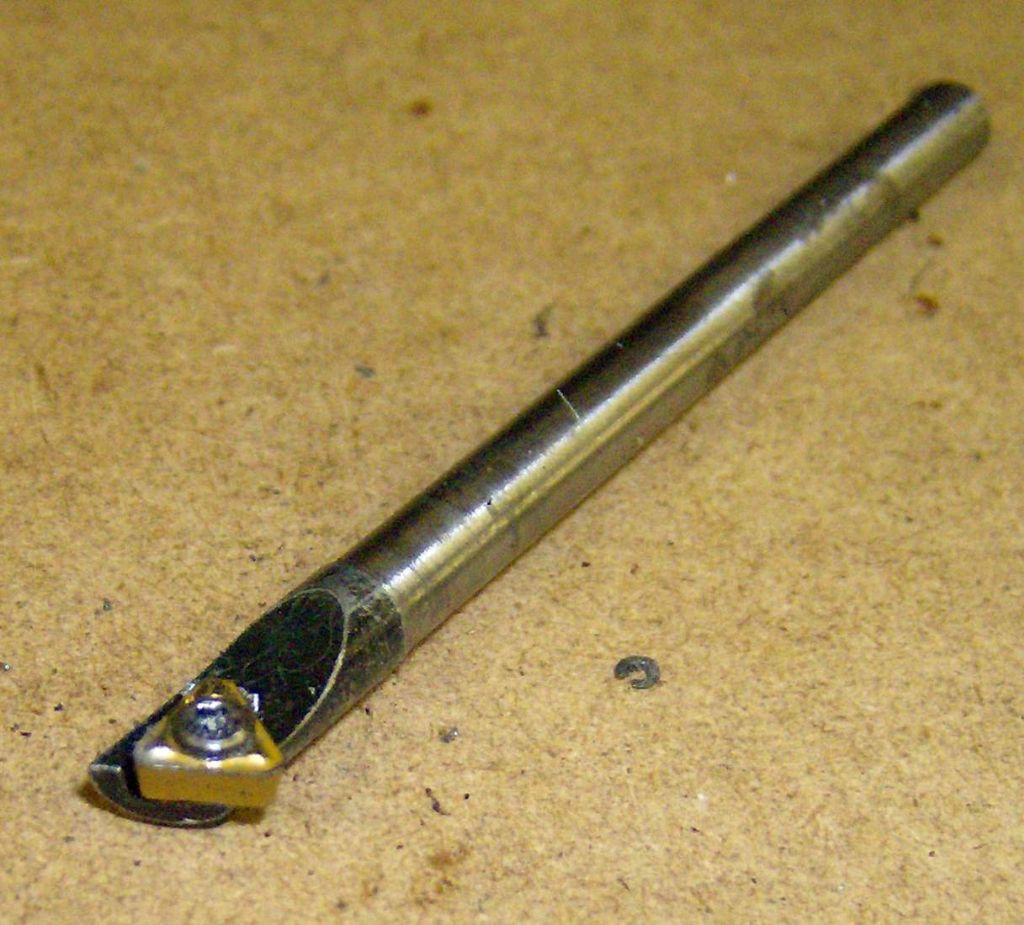I have been asked my thoughts on getting the best out of boring tools by someone who feels the cylinder boring thread left out the basics. They asked some specific questions, I'm no expert but I've taken pictures of different tools and here are my thoughts on each one, refering to the original questions.

This is one of a set of boring bars for use with a boring head – it can also be used in the toolpost held in a holder with a 3/8" bore. The questions were how do you align the tool with the lathe axis, and what is the right angle for the cutting edge?
The boring head usage makes it clear these are meant to be aligned with the late axis – the cutting edge will therefore be the front of the tool, and it will not cut along the side as this is slightly angle back.
The radial angle of the tool is more difficult. I find that unless the tool is set with absolutely no positive rake the cylindrical lower surface will rub. Ideally I guess it should be set with the top surface level and exactly at centre height, but in practice I always find I need to set it with a little negative rake.

This home made tool is essentially a D-bit ground from round HSS in a simple holder. Unlike the previous tool it needs to be angles slightly to give the side clearance. Unlike the previous too it seems to be less fussy about needing negative rake, perhaps because of the smaller diameter (1/4" .
.
It is OK for deep holes, but is rather flexible so it needs light cuts.

This tipped tool gave me alot of trouble until I spotted it was chipped! Using a fresh corner it works very well with teh cutter horizontal and at centre height. The shank is just 1/8" diameter but the depth of the insert is the limit on the hole diameter. If cuts are not heavy, is a good tool.

A traditional inserted cutter boring bar, in this case 3/8" inch diameter. replacing the allen head clamp screw with a brass one with the head butchered and filed away allows it to work down to 12mm/1/2" – the size of my largest twist drills. Unfortunately it cannot make a flat bottomed hole but at the other end an angle toolbit can do this – but it needs a bigger pilot hole to start from.
The 1/8" HSS toolbit has a rounded end and will give a satin finish on cast iron. It also allows the use of specialist tools for things like making internal grooves. Works best with the toolbit at centre height and can take cuts of up to 20 thou.
When the hole is small beware of chips gathering between the bore and the tool.

A commercially made boring tool from 1/4" HSS. this works very well as long as it isn't worked too hard, and obviously itopnly needs to be set on height. It is a godsend for putting a flat bottom on holes made with the heavier boring bar. Note the modest top rake.

The underside of the above tool, showing how I have releived it to allow it to work smaller diameters.

Finally "The Monster" a TCT -tipped beast with a 5/16"shank. A godsend for cast iron with chill spots or really deep holes. The only tool that could bore out the body of my Pott's Spidle which was badly chilled at the ends.
Needed much relief grinding using a green grit wheel to allow it to work smaller holes. It has a noticeable top rake.
Questions, criticism or furtehr suggestion and comment most welcome!
Neil
Sub Mandrel.




 .
.








